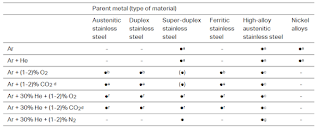The primary tasks of a shielding gas are to protect the weld pool from the influence of the atmosphere, i.e. from oxidation and nitrogen absorption, and to stabilize the electric arc. The choice of shielding gas can also influence the characteristics of the weld penetration profile.
SHIELDING GAS PROTECTION
Shielding gases for MIG/GMAW welding:
The basic gas for MIG/MAG welding is argon (Ar). Helium (He) can be added to increase penetration and fluidity of the weld pool. Argon or argon/helium mixtures can be used for welding all grades. However, small additions of oxygen (O ) or carbon dioxide (CO ) are usually needed to stabilize the arc, improve the fluidity and also improve the quality of the weld deposit. For stainless steels there are also gases available containing small amounts of hydrogen (H ). The table indicates the appropriate choice of shielding gas for MIG/MAG welding, taking account of different types of stainless steel and arc types.
a) Preferably in pulsed MIG welding.
b) Higher fluidity of the molten pool than with CO addition.
c) Except for Sandvik 22.12.HT and Sandvik 27.31.4.LCu where Ar is preferred.
d) Not to be used in spray-arc welding where extra low carbon is required.
e) Better short-arc welding and positional welding properties than with Ar + (1-2)% O .
f) Higher fluidity of the molten pool than with Ar. Better short-arc welding properties than with Ar + (1-2)% CO .
g) For nitrogen-alloyed grades.
Shielding gases for TIG/GTAW welding:
The normal gas for TIG welding is argon (Ar). Helium (He) can be added to increase penetration and fluidity of the weld pool. Argon or argon/helium mixtures can be used for welding all grades. In some cases nitrogen (N ) and/or hydrogen (H ) can be added in order to achieve special properties. For instance, the addition of hydrogen gives a similar, but much stronger effect as adding helium. However, hydrogen additions should not be used for welding martensitic, ferritic or duplex grades. Alternatively, if nitrogen is added, the weld deposit properties of nitrogen alloyed grades can be improved. Oxidizing additions are not used because these destroy the tungsten electrode. Recommendations for shielding gases used in TIG welding of different stainless steels are given in the table. For plasma-arc welding, the gas types with hydrogen additions in the table are mostly used as plasma gas, and pure argon as shielding gas.
a) Improves flow compared with pure Ar.
b) Preferably for automatic welding. High welding speed. Risk of porosity in multi-run welds.
Root protection:
A perfect welding result, without impairment of corrosion resistance and mechanical properties, can only be obtained when using a backing gas with very low oxygen content. For best results, a maximum of 20 ppm O at the root side can be tolerated. This can be achieved with a purging setup and can be controlled with a modern oxygen meter. Pure argon is by far the most common gas for root protection of stainless steels. Formiergas (N2 + 5 - 12% H2 ) is an excellent alternative for conventional austenitic steels. The gas contains an active component, H , which brings down the oxygen level in the weld area. Nitrogen can be used for duplex steels in order to avoid nitrogen loss in the weld metal. The purity of the gas used for root protection should be at least 99.995%. When gas purging is impractical root flux can be an alternative.
MOLTEN SLAG PROTECTION
In submerged-arc welding (SAW) and electro-slag welding (ESW), the shield is achieved by a welding flux, completely covering the consumable, the arc and the molten pool. The flux also stabilizes the electric arc. The flux is fused by the heat of the process, creating a molten slag cover that effectively shields the weld pool from the surrounding atmosphere.
Source: http://smt.sandvik.com/en/


Comments